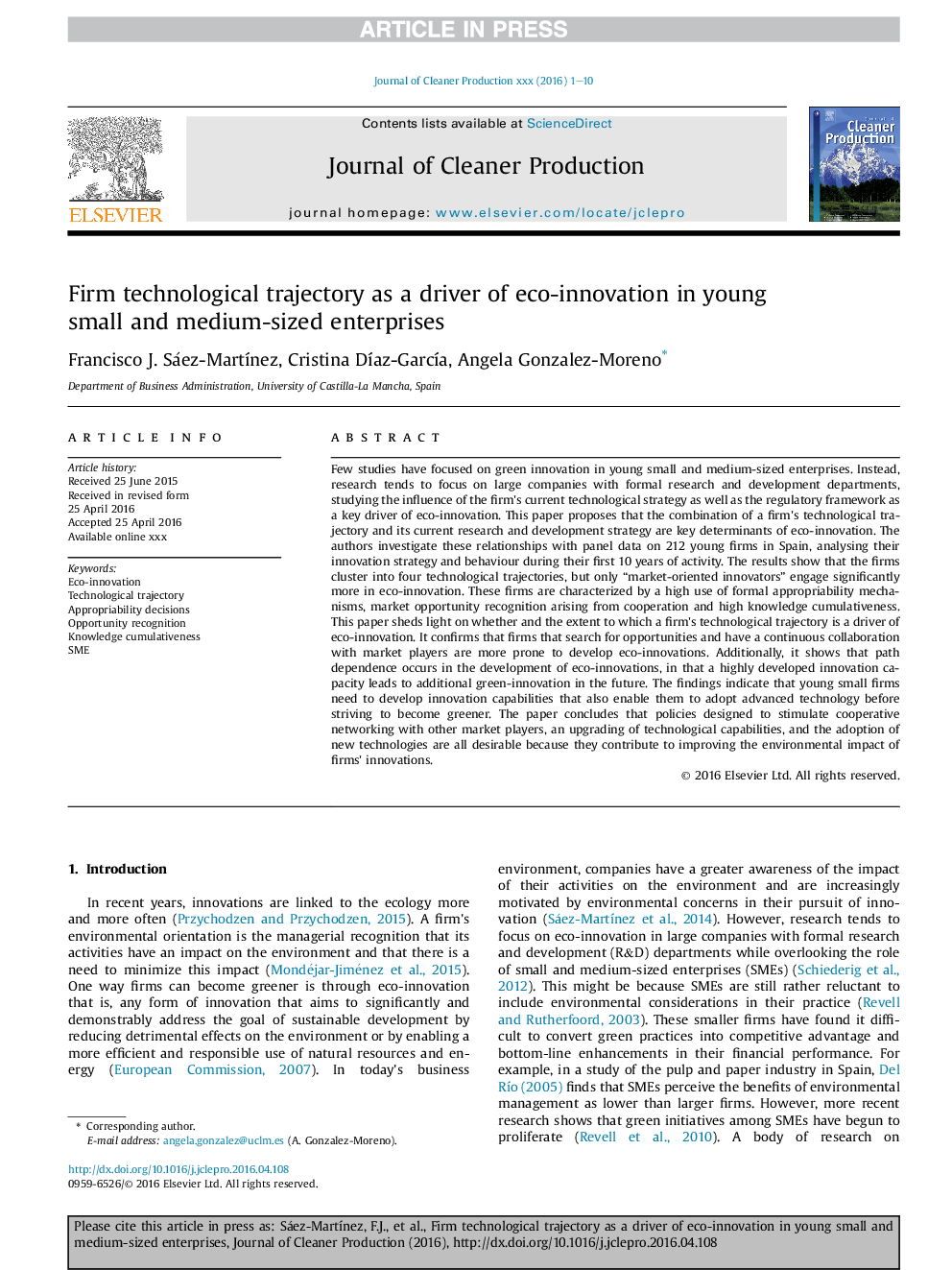| کد مقاله | کد نشریه | سال انتشار | مقاله انگلیسی | نسخه تمام متن |
|---|---|---|---|---|
| 5481580 | 1399336 | 2016 | 10 صفحه PDF | دانلود رایگان |
عنوان انگلیسی مقاله ISI
Firm technological trajectory as a driver of eco-innovation in young small and medium-sized enterprises
ترجمه فارسی عنوان
خط مشی تکنولوژی شرکت به عنوان یک راننده نوآوری در جوامع کوچک و متوسط
دانلود مقاله + سفارش ترجمه
دانلود مقاله ISI انگلیسی
رایگان برای ایرانیان
کلمات کلیدی
ترجمه چکیده
مطالعات اندکی بر نوآوری سبز در جوانان کوچک و متوسط تمرکز کرده است. در عوض، تحقیقات به شرکت های بزرگ با بخش های تحقیق و توسعه رسمی تمرکز می کند، و بررسی تاثیر استراتژی تکنولوژیک کنونی شرکت و همچنین چارچوب قانونی به عنوان یک راننده کلیدی برای نوآوری های زیست محیطی است. این مقاله پیشنهاد می کند که ترکیبی از یک مسیر تکنولوژیکی شرکت و استراتژی توسعه تحقیق و توسعه آن تعیین کننده های کلیدی برای نوآوری های زیست محیطی است. نویسندگان این روابط را با داده های پانل در 212 شرکت جوان در اسپانیا بررسی می کنند و استراتژی نوآوری و رفتار آنها را در ده سال اول فعالیت خود بررسی می کنند. نتایج نشان می دهد که شرکت ها به چهار مسیر تکنولوژیکی تقسیم می شوند، اما فقط یک نوآورانه بازار است. در نوآوری های زیست محیطی به طور قابل ملاحظه ای مشارکت می کند. این شرکت ها با استفاده زیاد از مکانیزم های رسمیت پذیری مشخص، شناخت فرصت های بازار ناشی از همکاری و جمع آوری اطلاعات بالا شناخته می شوند. این مقاله نشان می دهد که آیا و به چه میزان مسیری تکنولوژیک شرکت راننده ای از نوآوری های زیست محیطی است. این تایید می کند که شرکت هایی که به دنبال فرصت ها هستند و همکاری مداوم با بازیکنان بازار دارند بیشتر مستعد ابتلا به توسعه اقتصادی هستند. علاوه بر این، نشان می دهد که وابستگی به مسیر در توسعه نوآوری های زیستی رخ می دهد، در حالیکه یک ظرفیت نوآوری بسیار توسعه یافته در آینده سبب نوآوری سبز جدید می شود. یافته های این تحقیق نشان می دهد که شرکت های کوچک جوان نیاز به توسعه قابلیت های نوآوری دارند که همچنین آنها را قادر می سازد فناوری پیشرفته را قبل از تلاش برای تبدیل شدن به محیط زیست به کار گیرند. این مقاله نتیجه گیری می کند که سیاست های طراحی شده برای تحریک شبکه های همکاری با دیگر بازیکنان بازار، ارتقاء توانایی های تکنولوژیکی و پذیرش فن آوری های جدید مطلوب هستند، زیرا آنها به بهبود تاثیرات زیست محیطی نوآوری های شرکت ها کمک می کنند.
موضوعات مرتبط
مهندسی و علوم پایه
مهندسی انرژی
انرژی های تجدید پذیر، توسعه پایدار و محیط زیست
چکیده انگلیسی
Few studies have focused on green innovation in young small and medium-sized enterprises. Instead, research tends to focus on large companies with formal research and development departments, studying the influence of the firm's current technological strategy as well as the regulatory framework as a key driver of eco-innovation. This paper proposes that the combination of a firm's technological trajectory and its current research and development strategy are key determinants of eco-innovation. The authors investigate these relationships with panel data on 212 young firms in Spain, analysing their innovation strategy and behaviour during their first 10 years of activity. The results show that the firms cluster into four technological trajectories, but only “market-oriented innovators” engage significantly more in eco-innovation. These firms are characterized by a high use of formal appropriability mechanisms, market opportunity recognition arising from cooperation and high knowledge cumulativeness. This paper sheds light on whether and the extent to which a firm's technological trajectory is a driver of eco-innovation. It confirms that firms that search for opportunities and have a continuous collaboration with market players are more prone to develop eco-innovations. Additionally, it shows that path dependence occurs in the development of eco-innovations, in that a highly developed innovation capacity leads to additional green-innovation in the future. The findings indicate that young small firms need to develop innovation capabilities that also enable them to adopt advanced technology before striving to become greener. The paper concludes that policies designed to stimulate cooperative networking with other market players, an upgrading of technological capabilities, and the adoption of new technologies are all desirable because they contribute to improving the environmental impact of firms' innovations.
ناشر
Database: Elsevier - ScienceDirect (ساینس دایرکت)
Journal: Journal of Cleaner Production - Volume 138, Part 1, 1 December 2016, Pages 28-37
Journal: Journal of Cleaner Production - Volume 138, Part 1, 1 December 2016, Pages 28-37
نویسندگان
Francisco J. Sáez-MartÃnez, Cristina DÃaz-GarcÃa, Angela Gonzalez-Moreno,
